Menus
- A 1700 cc V2 at € 36,750 or a 5700 cc V8 at € 75,000 ?
- All the pleasures of motorcycling (or almost) … on three wheels
- Note:
- Discovery
- In the saddle
- In the city
- On motorways and main roads
- On departmental
- Part-cycle
- Brakes
- Comfort / duo
- Consumption / autonomy
- Conclusion
A 1700 cc V2 at € 36,750 or a 5700 cc V8 at € 75,000 ?
All the pleasures of motorcycling (or almost) … on three wheels
Well, we will agree right away: no, these are not motorcycles and the uncompromising fringe of our readership is invited to return here to read a test of Kawasaki Z750, it will avoid angry and messages on our forums… On the other hand, curious and open-minded spirits, welcome: three-wheelers on the Den, why not, especially as the mechanical bases are those of well-known motorcycles: on the one hand, the Harley-Davidson Electra Glide and on the other, the Boss Hoss V8 6.2, which the Den recently offered you a full test drive.
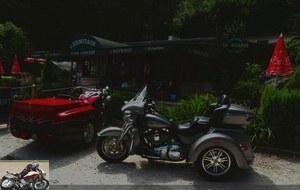
The general public calls them trikes whereas their historical name is rather that of "serviced cars". The trike, today, is generally wider and lower, has two or three seats, and is often powered by a flat four cylinder engine from the VW Beetle (but these are found with inline 4s from Renault 19 or Ford Escort ).
Historically, the service car was in fact a motorcycle to which a rear axle was grafted to improve its practical aspects: military vehicles, police vehicles, or a machine to deliver milk or newspapers, the applications have been multiple and a firm as Harley-Davidson produced thousands of them from 1932 until 1974. But other players came into this niche, such as Indian, before Harley. And let’s not forget the hundreds of thousands of Asian rickshaws, which actually follow the same concept.
Why then drive a trike (or a utility car)? Good question, in which all those who think that life is too short to ride sad and switch to the same soulless cattle trailers as everyone else will find themselves. That, if you are looking for "difference", these two machines will allow you to surpass yourself! Their price and their lack of practicality in an urban environment (although, to go shopping, you will appreciate the trunk!) Does not put them within the reach of all budgets and all uses, it’s true. But you may want to drive a serviced coach for many other reasons: its carrying capacity when traveling, its stability, its ease of driving, the possibility of having access to a fantastic escape machine when the age, disability or physical condition keep you away from the practice of two-wheelers, or your ability to be driven without a motorcycle license (a B license is sufficient with, depending on the case, a 7-hour training course).
This is to answer purely pragmatic questions: but the service car has an irrational side. You can be a fan of mechanics and US culture and totally fall for these machines, which have a fairly phenomenal capital of attraction among the general public….
Note:
This comparison was made this summer with a Tri-Glide Ultra and its 103 ci engine. As of this fall, the entire Harley Touring lineup features the new generation Milwaukee Eight 107 and 114 ci engines. The Tri-Glide Ultra therefore now comes with the twin-cooled 107 (1750), which we tested in the USA in the Ultra Limited Low. In fact, the power gains ten horses to graze the 90 horses, the couple gains 11% (152 Nm at 3250 rpm). Consumption would be down and acceleration from 0 to 100 would also be up by 11%. The engine heat rises would also be better contained. On the other hand, the price goes to 37,650 €. In short, a small welcome supplement, but nothing that does not fundamentally change the conclusions of this unusual face to face..
Discovery
In the small world of motorcycles, we will say that a Harley-Davidson Electra Glide is a big machine compared to the all-rounder of production. A good big V2 of 1700 cm3 (or 850 per cylinder!), 394 kilos dry, 2.60 meters long: hello the piece !
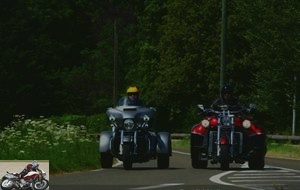
But with the Tri Glide Ultra, we go to 545 kilos dry and 1.39 meters wide: it’s big, but ultimately it remains 11 cm narrower than a first generation Smart. The Tri Glide Ultra takes, of course, all the latest Harley technologies, including the infotainment Boom Box !, with its touch screen, GPS, a sound system downright correct since the radio remains audible at 130 km / h on the highway. , all of which can be handled in an obvious and natural way by complete, but ergonomic, stalk switches.
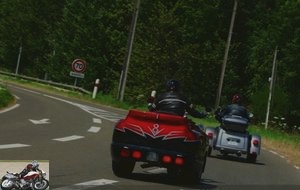
Except that facing the Boss Hoss, the Harley looks like a carounet! Because the Boss Hoss is something else altogether! With 1.52 m wide and 3.5 m long, she boxed squarely in another category. Not to mention the phantasmagorical effect that the V8 always provides. Compared to the recently tested Boss Hoss, our daily service car has an older generation engine: here, it is not the LS3 unit of the current Chevrolet Camaro and Corvette, but the ZZ4 unit (5700 cm3) of the older ones. generations. You know what ? We will be satisfied with it, because it develops anyway 385 horsepower at 5,200 rpm and 56 m / kg of torque at 4,200 rpm. This should be enough to move its 680 kilos dry (plus 40 liters of gasoline, 28 in the main tank and 12 in the secondary tank, located in the trunk). Opposite, the Harley-Davidson Tri Glide Ultra is obviously more modest, but one of the truths of American mobility is that nothing replaces displacement (nothing replaces the displacement) and that is verified once more ! The Harley develops around 80 horsepower at 5200 rpm (Milwaukee does not communicate on the power, but US sites have passed 1700 blocks to the bench) and 138 Nm of torque at 3750 rpm, connected to a classic 6 box, when the Boss Hoss and this is not a slight difference compared to the solo bike, relies on a converter automatic and three gears.
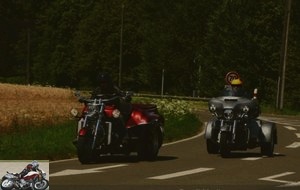
If the size and the mechanical configuration of our machines have enough to nail the beak of the boeotiens, the fittings and the equipment are in tune. On the Harley, we will highlight the quality of the assembly, the finish, the surface treatments, the richness of the equipment and the exhaustiveness of the commodos, while the Boss Hoss seduces with its chrome, calls out for its gigantic radiator , its massive commodos and its central console on the tank, more than complete.
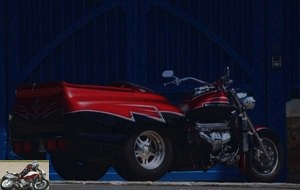
Note that the legislation requires our vehicles to have separate dipped beam headlights (so that vehicles crossing them become aware of their width). As a result, the traditional central headlight is not put to use: on the Harley, it is even a plastic lure..
In the saddle
Do not think that the absence of a center stand always makes life easier! We are thinking in particular of those who have chosen to drive a serviced coach for physical disability because getting on board is not absolutely obvious. Our two machines have one thing in common: a fairly large butt; a rather high passenger seat and, in the case of the Harley, a top case. You will therefore need a particularly flexible and alert leg to step over all this with an elegant gesture, without wallowing..

The simplest: take support on the foot step, the one located on the side wall of the Boss Hoss and on the Harley, the passenger footrest plate can do this. Then let yourself go down smoothly on the rider’s saddle.
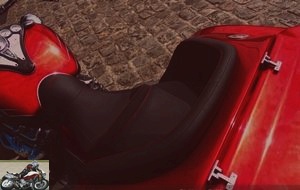
Once on board, it’s like on the corresponding motorcycles. The Harley-Davidson seduces with its complete equipment, its dual-branch selector, like on an Electra Glide, in short. So you just have to remove the "hand-on-foot" brake (a pedal located under the left footrest plate) and presto, you’re a biker. Boss Hoss side, automatic gearshift lever on "Parking", pressure on the starter and the V8 comes to life. Just in the sound, fat and deep, you just realized that you are going to leave for an extraordinary experience. But with the arms crossed on the wide handlebars, the legs wide apart and the big V8 in the middle, there was no doubt about it..
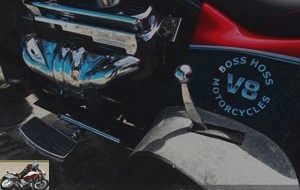
Compared to the Boss Hoss solo, the trike has an advantage: its size allows it to accommodate a classic automatic transmission, a good old three-speed Torqueflite, such as we found on American cars of the 1960s. ‘performs in a classic way, with the "P; R; N; D" grid familiar to those familiar with the genre. A few shots of empty gas show that the gigantic reversing torque is there to wander from left to right, but this time, stability is there..
In the city
Do you like the interface? Ben will have to forget. In fact, just like sidecar or Can Am Spyder users, servicecan owners experience traffic. The first reflex to take is to clearly define the size of these machines and to ride in the middle of its lane, at the risk of quickly getting out of the amicable report..
Once we took the compass in the eye (that’s an expression, don’t go hurt yourself) and accepted the idea that we were going to have to drag ourselves behind Dacia Dusters and a slew of smelly TDI cars, the city test is not a chore especially as despite yourself, you will become a star, the target of thumbs up, stares of amazement and photos smartphone taken.

The two machines can be taken away quite easily, each having their strong point: for the Boss Hoss, the automatic gearbox makes it easier, basically, you let it go on "Drive" and you manage everything with a little gas, in the deep rumble of the V8, which turns heads of connoisseurs. On the Harley, we appreciate both straightforward and firm controls, Harley style, and the superior agility of the Tri Glide compared to its competitor of the day. A common defect: the heat build-up of the engines, which our summer test highlighted.
Both machines have a reverse gear, easier to access on the Boss Hoss (just put the lever in "R"); the Harley-Davidson requires the use of the "R" key on the left commodo.
At low speed, our two serviced cars can be driven with ease: to turn, all you have to do is turn the handlebars … It will get a little complicated on small roads….
On motorways and main roads
This is the preferred territory of our two cruising machines. Obviously, on the power side, the Harley leaves with a certain deficit, but in the end, it is not that obvious if we consider the relaxed driving position, the vocation of our machines and the specificities of their chassis. In truth, they are good machines to cut kilometers by pack of miles, easy … Note that the Boss Hoss can be delivered with a windshield, which equalizes their protection in the wind..

Obviously, the Boss Hoss works harder: nevertheless its three-speed Torqueflite favors absolute smoothness (it’s quite simple, if you are not careful, you do not even feel the reports pass) and, on the reactivity side. , it is at the antipode of a Honda DCT in "Sport 3" mode. You have to insist on the handle to get a kick-down and, in this case, the acceleration becomes really sustained from mid-revs, always in this muffled and inimitable rumble..
The Harley, on the other hand, is not that lagging behind: because its final transmission ratio has been adapted accordingly. At 3000 rpm in sixth, where you find yourself at around 130 km / h on a 1700 Big Twin of the range such as the recently tested Road Glide Ultra, the Tri Glide is at 110 km / h: availability has logically been privileged on top speed. The Boss Hoss pulls longer (but it can!): The V8 purrs at 2,500 rpm at 130 km / h.

In both cases, the stability does not call for criticism and these machines let themselves be carried away smoothly: their inertia and their particular driving style will make you favor fluid trajectories and tangent arabesques, but neither of the two gives you any fear. high speed, as long as they are driven as it should, with the minimum of anticipation. But as a motorway slip road arrives (and closes!) Quickly, we will read the following paragraph carefully..
On departmental
Because arriving too quickly in a bend with a serviced bus is the best way to go straight! And Paf, the dog, burst into the weeping willow! As it does not tilt, the servo car has a natural inertia that makes it want to understeer. Only method: grab the handlebars, turn in the direction of the turn and throttle! To put it simply, our machines behave like quads that we wouldn’t slide: turn the handlebars towards the inside of the bend, inside arm bent and outside arm outstretched; the faster you want to go, the more it will be necessary to accompany the whole by moving the mass of your body inwards a little.
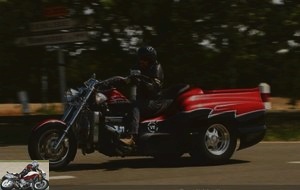
Driving these machines is therefore not fundamentally complicated but it will always be preferable to go slowly at the beginning and, in all circumstances, to favor the exits of curves (ah the rumble of the V2, ah, the roar of the V8 !) as the entrances, where the weight is remembered to you. With a lot of common sense and a little arm, these servo cars are ultimately docile: let’s not forget that some of their customers can be a bit old or physically challenged. Be careful with the Boss Hoss, however, because with the potato available (generously!) And in the absence of a self-locking differential, you quickly end up making the inside tire wax when you go around when exiting the curve. It’s funny … but the device, at some point, will be tempted to bite you…
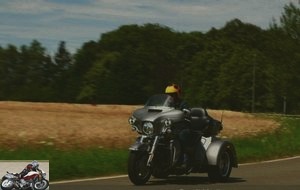
On small bumpy roads, the Boss Hoss is paradoxically more to its advantage than the Harley: heavier, longer, wider, the V8 is overall more stable than the V2. The Harley suffers here from its rigid rear axle where, as on traditional 4x4s, a bump encountered by the left rear wheel will affect the right and vice versa. On a rough road, it shakes up seriously, to the point of eventually having to reduce speed, if only to preserve the passenger…
Part-cycle
The advantage of these "factory" serviced cars is that their geometry has been optimally calculated. Some "after market" manufacturers who stick axles on the back of a motorcycle (there are several players on the market, who mainly transform Harley, GoldWing and Japanese custom) do not necessarily have the means. to go so far in detail. Thus, on the Tri Glide, Harley-Davidson also modified the front axle, which in both cases has a caster angle of 26 °, but a trail of 170 mm on an Electra Glide Ultra Classic. , reduced to 100 mm on the Tri Glide, which also uses a 16-inch wheel in front, where an Electra Glide is in 17. As for the rear, we go from a 180/65 x 16 on an Electra twice 205/65 x 15 on the Tri Glide.
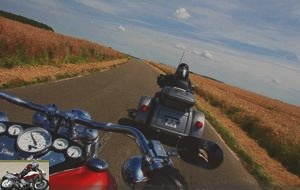
The Harley-Davidson also offers a steering damper which definitely helps with front stability, where the Boss Hoss, which lacks it, can wiggle its nose over bumps and require a firm grip on the handle. handlebar !
In both cases and given the dry weights (with an overweight of 150 kg on the Harley and 180 kg on the Boss Hoss, compared to standard motorcycles), we suspect that the chassis are of the solid type. The Boss Hoss, for example, puts its power through two big 275/60 x 15 at the rear and has a solid inverted 63 mm (!) Front fork..
Brakes
No ABS on our machines, but correctly dimensioned braking systems: and with the rubber surface on the ground, there is already enough to brake without being afraid.
Advantage, however, to the Harley, whose braking power seemed to us superior to that of the Boss Hoss; however, let us specify that the Harley was new while the Boss Hoss already had a few hours of flight, it is less heavy and it also arrives less quickly in the bends. That said, the Harley has front discs with 6-piston calipers, coupled to each of the two rear discs, which have 4-piston calipers, plus a single-piston caliper for the handbrake..
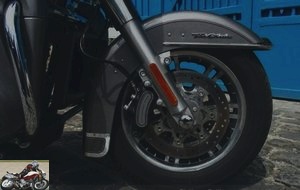
The Boss Hoss, it entrusts its handbrake to the "P" position of the automatic gearbox, which blocks the transmission. The braking at the front (2 discs of 306 mm, with 4-piston calipers) seemed to us less efficient than that of the Harley, while the two discs at the rear, each pinched by a 2-piston caliper, complete the set without too much zeal: in fact, in the photoshoots, where you arrive a little quickly in a curve, you brake hard to turn around and you start again, again and again, braking the Boss Hoss quickly began to feel the heat and to lose his effectiveness. But again, the machine had a few hours of flight time … and you can always count on the engine braking of the V8..
In both cases, even during strong decelerations, our two machines brake well in line and do not pose any stability problems: reassuring, even if, to be honest, we did not seek the limits, like a brutal braking of the rear in a wet bend on a slope.
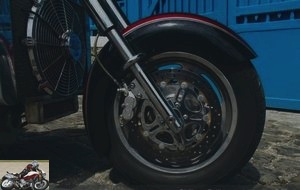
Comfort / duo
For travel, we appreciate the carrying capacity of the Harley, which is 190 liters (that’s more than what a Fiat 500 offers!) And 169 liters "only" for the Boss Hoss (but it took housing the automatic gearbox and the rear axle takes up space). Still, these machines allow you to cut the road with a certain ease..
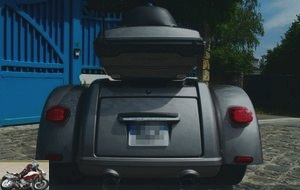
In terms of comfort, for the pilot, it is relatively identical to the handlebars of the Tri Glide compared to an Electra Glide: it is therefore of a very high level. Very correct on good surfaces (like, as we can imagine, that of most American Interstates on which the majority of its customers will take it), the rear suspension is much more jerky on bumps and makes the vehicle lose points. Harley, which the passenger may find tiring after a while. The Boss Hoss is more serene in this case.
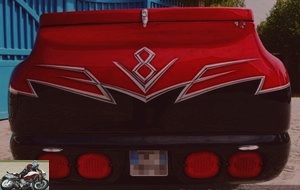
Consumption / autonomy
Big Harleys are sober and a cruising Big Twin 1700 can be satisfied with barely 5.5 l / 100, which is reasonable considering the weight of the beast. But the Tri Glide is heavier, less aero and pulls shorter: no miracles, consumption climbs and will often be between 8 and 9 liters per hundred. With the 22.7-liter tank, we therefore aim for refueling every 300 kilometers, against every 400 on its two-wheeled cousin. We were not able to measure the consumption of the Boss Hoss with precision, but the contribution of the conventional automatic gearbox should allow us to hope to cruiser between 10 and 15 l / 100. Reasonable, right? (that said, this is the first time in my career that I refueled more than 50 euros on a "motorcycle").
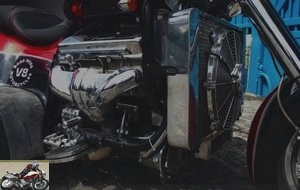
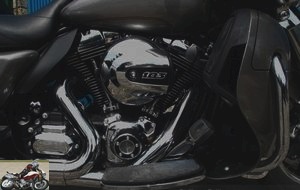
Conclusion
Like all extraordinary machines, our two machines have a tremendous power of sympathy: from 7 to 77 years old, they attract attention and fuel conversations. Afterwards, it does not matter if we choose them for their unconventionality, or because they meet an expectation in terms of license or balance. !
At € 36,750, the Tri Glide Ultra is € 9,000 more expensive than an equivalent Electra Glide Ultra Classic. With him, we therefore enter the Harley universe at 100%, because he delivers this same inimitable sensory universe, a mixture of sound and motor character, of the feel of the controls, of such particular noises (ah, the klonk! Of the box ). For some, it is an art of living that does not suffer from any imitation or alternative.

As in the case of the solo motorcycle, the Boss takes you into another world, downright exceptional. Let us even dare to say that the servo-car is more successful in this concept of excessiveness which alone constitutes the Boss Hoss: the overturning torque of the Boss Hoss solo, its balance during maneuvers, its transmission with a little shadok overdrive, all this gives it a scary side. Sold € 75,000 instead of € 72,000 (and available with several types of rear, Chevrolet Corvette style as on our model, or pick-up truck, or even Hot Rod Chevrolet ’57), the 2016-style serviced car comes with its 6.2 block (445 hp) and a real 4-speed automatic gearbox. That is to say all the advantages of the Boss Hoss, its look, its performance, the approval of its extraordinary engine, its daunting acceleration … without the disadvantages.
Dear ? Maybe … But for those who want to know what it’s like, the Boss Hoss importer, American Bikes Custom and Cars (based in Thiais, 94), offers serviced car rentals from € 185 per day , which is reasonable for a walk full of memories, or traces of gum on the asphalt, as desired !
Either way, Tri Glide or Boss Hoss are a great way to experience the Road in a different way. Down with conformism: life is too short to ride sad !
Strong points
- Harley-Davidson Tri Glide Ultra
- Build quality
- Flexibility of V2
- Saddle comfort
- Ease of driving
- "Almost" reasonable gauge
- Sound quality
- State-of-the-art BoomBox infotainment
- "Wow!" guaranteed
- Boss Hoss Trike V8
- Magic of V8 !
- Automatic gearbox that suits it perfectly
- Exploding performance, sound
- Ease of driving
- Stability
- "Super wow!" guaranteed
Weak points
- Harley-Davidson Tri Glide Ultra
- Average rear axle comfort on bumps
- High price
- High consumption
- V2 heat rises in town
- Boss Hoss Trike V8
- Impressive template
- V8 heat rises
- Very high price (although, compared to the motorcycle …)
- Boot volume compared to the template !
- Average braking
Datasheet
Test conditions
- Itinerary: a day of use around Paris for the Boss Hoss, a short week with the Harley
- Motorcycle mileage: 900 km for the Harley, 50,000 for the Boss Hoss
- Problem encountered: returning a machine with a V8, it is never a joy of heart…
Related articles
-
Harley-Davidson Electra Glide Ultra Limited Review
The 103 daddy With its 1,690 cm3 engine, the Electra-Glide Ultra Limited makes it possible to take a step ahead of what the ultra classic will cub in a…
-
Comparo Harley-Davidson Street Glide 107 & Road Glide 107
Which model of the touring range to cut the road ? V2, 1745 cm3, around 90 hp, 150 Nm, from 376 kilos fully loaded, from 26,890 € Some manufacturers have…
-
Harley-Davidson Road Glide CVO 117 test
Welcome to excess Harley-Davidson V2, 1923 cm3, 105 hp at 5450 rpm, 166 Nm at 3500 rpm, 385 kilos dry, from € 41,290 From when, too much is enough? What…
-
Comparo Harley-Davidson Sportster 1200 Forty-Eight Special & Iron
Two visions quite close to the cool and relaxed motorcycle V2, 1202 cm3, 66 hp, 98 Nm, 248 kilos, from 11,290 € One thousand nine hundred and…
-
Harley-Davidson Road Glide Ultra test
1700 cm3, 80 hp, 138 Nm of torque, cruise control, GPS, audio, € 27,850 A test over almost 4,000 kilometers from Paris to Porto via Wheels Waves and…
-
Harley-Davidson CVO Street Glide 114 test
V2, 1868 cm3, around 100 hp, 165 Nm, 398 kilos with full fuel, € 39,550 A certain vision of the exception made in Milwaukee and a really punchy 114…
-
Harley-Davidson CVO Street Glide Test Drive
Fantastic ride … on the spine of the eagle. Legend AND myth, this is the concept of a Harley Davidson CVO (Custom Vehicle Operations). The Milwaukee…
-
Harley-Davidson Sport Glide 107 Test
Touring and sport at the same time: absolute versatility according to Harley V2, 1745 cm3, 84 hp at 5400 rpm, 145 Nm at 3250 rpm, 304 dry kilos, from €…
-
Exceptional test: Boss Hoss BHC3-LS3
A Chevrolet Camaro 6.2 V8: 445 hp, 57 m / kg of torque, 484 kilos dry, € 72,000 The biggest motorcycle in the world delivers absolutely unique sensations…
-
Comparo Harley-Davidson Fat Boy Slim S
New life Recently unveiled, the 2016 Harley Davidson range is darker as desired by the Dark Custom program. A contemporary underground movement that the…